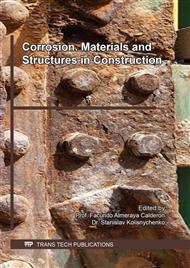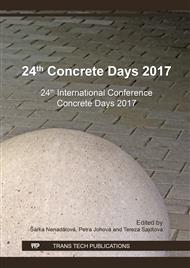p.166
p.172
p.178
p.185
p.189
p.197
p.203
p.209
p.214
Study of Corrosion Damage of Glass Fibers in Textile Fiberglass Reinforcement under Expositions Simulating Concrete Environment
Abstract:
The main point of this paper is to assess the level of corrosion damage of the composite textile fiberglass reinforcement in environments that simulate the concrete pore solution by the techniques of FT-IR (Fourier transform infrared spectroscopy), SEM (scanning electron microscopy) as well as EDS (scanning electron microscopy). Effect of corrosion on the tensile strength segmented textile glass fiber was tested and also it was investigated specific type of protective organic coating on glass fiber. The results express the evidence of local corrosion damage on the examined samples just at pH 13.5, and on the contrary high stability in the environment simulating carbonated concrete and concrete contaminated by chloride anions. The thesis also points on the unevenness of the excluded protective organic coating with localized porosity which relates to the above mentioned corrosion damage.
Info:
Periodical:
Pages:
189-196
Citation:
Online since:
February 2018
Authors:
Price:
Сopyright:
© 2018 Trans Tech Publications Ltd. All Rights Reserved
Share:
Citation:



